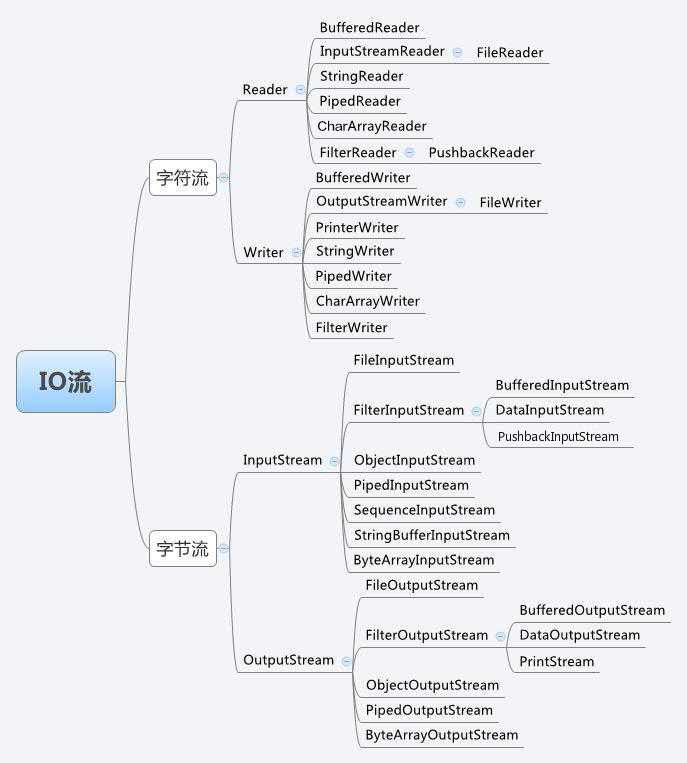标签:类型 包装类 toc rename head 进程 读文件 类库 col
Java IO即Java 输入输出系统。不管我们编写何种应用,都难免和各种输入输出相关的媒介打交道,其实和媒介进行IO的过程是十分复杂的,这要考虑的因素特别多,比如我们要考虑和哪种媒介进行IO(文件、控制台、网络),我们还要考虑具体和它们的通信方式(顺序、随机、二进制、按字符、按字、按行等等)。Java类库的设计者通过设计大量的类来攻克这些难题,这些类就位于java.io包中。
在JDK1.4之后,为了提高Java IO的效率,Java又提供了一套新的IO,Java New IO简称Java NIO。它在标准java代码中提供了高速的面向块的IO操作。本篇文章重点介绍Java IO,关于Java NIO请参考我的另两篇文章:
高级Java工程师必备 ----- 深入分析 Java IO (一)BIO
高级Java工程师必备 ----- 深入分析 Java IO (二)NIO
首先看个图:

虽然java IO类库庞大,但总体来说其框架还是很清楚的。从是读媒介还是写媒介的维度看,Java IO可以分为:
而从其处理流的类型的维度上看,Java IO又可以分为:
下面这幅图就清晰的描述了JavaIO的分类:
| - | 字节流 | 字符流 |
|---|---|---|
| 输入流 | InputStream | Reader |
| 输出流 | OutputStream | Writer |
我们的程序需要通过InputStream或Reader从数据源读取数据,然后用OutputStream或者Writer将数据写入到目标媒介中。其中,InputStream和Reader与数据源相关联,OutputStream和writer与目标媒介相关联。
通过上面的介绍我们已经知道,字节流对应的类应该是InputStream和OutputStream,而在我们实际开发中,我们应该根据不同的媒介类型选用相应的子类来处理。下面我们就用字节流来操作文件媒介:
例1,用字节流写文件
public static void writeByteToFile() throws IOException{ String hello= new String( "hello word!"); byte[] byteArray= hello.getBytes(); File file= new File( "d:/test.txt"); //因为是用字节流来写媒介,所以对应的是OutputStream //又因为媒介对象是文件,所以用到子类是FileOutputStream OutputStream os= new FileOutputStream( file); os.write( byteArray); os.close(); }
例2,用字节流读文件
public static void readByteFromFile() throws IOException{ File file= new File( "d:/test.txt"); byte[] byteArray= new byte[( int) file.length()]; //因为是用字节流来读媒介,所以对应的是InputStream //又因为媒介对象是文件,所以用到子类是FileInputStream InputStream is= new FileInputStream( file); int size= is.read( byteArray); System. out.println( "大小:"+size +";内容:" +new String(byteArray)); is.close(); }
package com.chenhao.io.byteIO; import java.io.File; import java.io.FileInputStream; import java.io.FileNotFoundException; import java.io.FileOutputStream; import java.io.IOException; import java.io.InputStream; import java.io.OutputStream; /** * @author ChenHao * */ public class CopyFileDemo { /** * @param args * @throws FileNotFoundException */ public static void main(String[] args) { String src ="E:/xp/test"; String dest="e:/xp/test/4.jpg"; try { copyFile(src,dest); } catch (FileNotFoundException e) { e.printStackTrace(); System.out.println("文件不存在"); } catch (IOException e) { e.printStackTrace(); System.out.println("拷贝文件失败|关闭流失败"); } } /** * 文件的拷贝 * @param 源文件路径 * @param 目录文件路径 * @throws FileNotFoundException,IOException * @return */ public static void copyFile(String srcPath,String destPath) throws FileNotFoundException,IOException { //1、建立联系 源(存在且为文件) +目的地(文件可以不存在) File src =new File(srcPath); File dest =new File(destPath); if(! src.isFile()){ //不是文件或者为null System.out.println("只能拷贝文件"); throw new IOException("只能拷贝文件"); } //2、选择流 InputStream is =new FileInputStream(src); OutputStream os =new FileOutputStream(dest); //3、文件拷贝 循环+读取+写出 byte[] flush =new byte[1024]; int len =0; //读取 while(-1!=(len=is.read(flush))){ //写出 os.write(flush, 0, len); } os.flush(); //强制刷出 //关闭流 os.close(); is.close(); } }
同样,字符流对应的类应该是Reader和Writer。下面我们就用字符流来操作文件媒介:
例3,用字符流读文件
public static void writeCharToFile() throws IOException{ String hello= new String( "hello word!"); File file= new File( "d:/test.txt"); //因为是用字符流来读媒介,所以对应的是Writer,又因为媒介对象是文件,所以用到子类是FileWriter Writer os= new FileWriter( file); os.write( hello); os.close(); }
例4,用字符流写文件
public static void readCharFromFile() throws IOException{ File file= new File( "d:/test.txt"); //因为是用字符流来读媒介,所以对应的是Reader //又因为媒介对象是文件,所以用到子类是FileReader Reader reader= new FileReader( file); char [] byteArray= new char[( int) file.length()]; int size= reader.read( byteArray); System. out.println( "大小:"+size +";内容:" +new String(byteArray)); reader.close(); }
字节流可以转换成字符流,java.io包中提供的InputStreamReader类就可以实现,当然从其命名上就可以看出它的作用。其实这涉及到另一个概念,IO流的组合,后面我们详细介绍。下面看一个简单的例子:
例5 ,字节流转换为字符流
public static void convertByteToChar() throws IOException{ File file= new File( "d:/test.txt"); //获得一个字节流 InputStream is= new FileInputStream( file); //把字节流转换为字符流,其实就是把字符流和字节流组合的结果。 Reader reader= new InputStreamReader( is); char [] byteArray= new char[( int) file.length()]; int size= reader.read( byteArray); System. out.println( "大小:"+size +";内容:" +new String(byteArray)); is.close(); reader.close(); }
例6 ,File操作
public class FileDemo { public static void main(String[] args) { //检查文件是否存在 File file = new File( "d:/test.txt"); boolean fileExists = file.exists(); System. out.println( fileExists); //创建文件目录,若父目录不存在则返回false File file2 = new File( "d:/fatherDir/subDir"); boolean dirCreated = file2.mkdir(); System. out.println( dirCreated); //创建文件目录,若父目录不存则连同父目录一起创建 File file3 = new File( "d:/fatherDir/subDir2"); boolean dirCreated2 = file3.mkdirs(); System. out.println( dirCreated2); File file4= new File( "d:/test.txt"); //判断长度 long length = file4.length(); //重命名文件 boolean isRenamed = file4.renameTo( new File("d:/test2.txt")); //删除文件 boolean isDeleted = file4.delete(); File file5= new File( "d:/fatherDir/subDir"); //是否是目录 boolean isDirectory = file5.isDirectory(); //列出文件名 String[] fileNames = file5.list(); //列出目录 File[] files = file4.listFiles(); } }
通过上面的例子我们已经知道,我们可以用FileInputStream(文件字符流)或FileReader(文件字节流)来读文件,这两个类可以让我们分别以字符和字节的方式来读取文件内容,但是它们都有一个不足之处,就是只能从文件头开始读,然后读到文件结束。
但是有时候我们只希望读取文件的一部分,或者是说随机的读取文件,那么我们就可以利用RandomAccessFile。RandomAccessFile提供了seek()方法,用来定位将要读写文件的指针位置,我们也可以通过调用getFilePointer()方法来获取当前指针的位置,具体看下面的例子:
例7,随机读取文件
public static void randomAccessFileRead() throws IOException { // 创建一个RandomAccessFile对象 RandomAccessFile file = new RandomAccessFile( "d:/test.txt", "rw"); // 通过seek方法来移动读写位置的指针 file.seek(10); // 获取当前指针 long pointerBegin = file.getFilePointer(); // 从当前指针开始读 byte[] contents = new byte[1024]; file.read( contents); long pointerEnd = file.getFilePointer(); System. out.println( "pointerBegin:" + pointerBegin + "\n" + "pointerEnd:" + pointerEnd + "\n" + new String(contents)); file.close(); }
例8,随机写入文件
public static void randomAccessFileWrite() throws IOException { // 创建一个RandomAccessFile对象 RandomAccessFile file = new RandomAccessFile( "d:/test.txt", "rw"); // 通过seek方法来移动读写位置的指针 file.seek(10); // 获取当前指针 long pointerBegin = file.getFilePointer(); // 从当前指针位置开始写 file.write( "HELLO WORD".getBytes()); long pointerEnd = file.getFilePointer(); System. out.println( "pointerBegin:" + pointerBegin + "\n" + "pointerEnd:" + pointerEnd + "\n" ); file.close(); }
BufferedInputStream顾名思义,就是在对流进行写入时提供一个buffer来提高IO效率。在进行磁盘或网络IO时,原始的InputStream对数据读取的过程都是一个字节一个字节操作的,而BufferedInputStream在其内部提供了一个buffer,在读数据时,会一次读取一大块数据到buffer中,这样比单字节的操作效率要高的多,特别是进程磁盘IO和对大量数据进行读写的时候,能提升IO性能。
使用BufferedInputStream十分简单,只要把普通的输入流和BufferedInputStream组合到一起即可。我们把上面的例2改造成用BufferedInputStream进行读文件,请看下面例子:
例10 ,用缓冲流读文件
public static void readByBufferedInputStream() throws IOException { File file = new File( "d:/test.txt"); byte[] byteArray = new byte[( int) file.length()]; //可以在构造参数中传入buffer大小 InputStream is = new BufferedInputStream( new FileInputStream(file),2*1024); int size = is.read( byteArray); System. out.println( "大小:" + size + ";内容:" + new String(byteArray)); is.close(); }
BufferedOutputStream的情况和BufferedInputStream一致,在这里就不多做描述了。
package com.chenhao.io.buffered; import java.io.BufferedInputStream; import java.io.BufferedOutputStream; import java.io.File; import java.io.FileInputStream; import java.io.FileNotFoundException; import java.io.FileOutputStream; import java.io.IOException; import java.io.InputStream; import java.io.OutputStream; /** * 字节流文件拷贝+缓冲流 ,提高性能 * 缓冲流(节点流) * @author ChenHao * */ public class BufferedByteDemo { public static void main(String[] args) { String src ="E:/xp/test"; String dest="e:/xp/test/4.jpg"; try { copyFile(src,dest); } catch (FileNotFoundException e) { e.printStackTrace(); System.out.println("文件不存在"); } catch (IOException e) { e.printStackTrace(); System.out.println("拷贝文件失败|关闭流失败"); } } /** * 文件的拷贝 * @param 源文件路径 * @param 目录文件路径 * @throws FileNotFoundException,IOException * @return */ public static void copyFile(String srcPath,String destPath) throws FileNotFoundException,IOException { //1、建立联系 源(存在且为文件) +目的地(文件可以不存在) File src =new File(srcPath); File dest =new File(destPath); if(! src.isFile()){ //不是文件或者为null System.out.println("只能拷贝文件"); throw new IOException("只能拷贝文件"); } //2、选择流 InputStream is =new BufferedInputStream(new FileInputStream(src)); OutputStream os =new BufferedOutputStream( new FileOutputStream(dest)); //3、文件拷贝 循环+读取+写出 byte[] flush =new byte[1024]; int len =0; //读取 while(-1!=(len=is.read(flush))){ //写出 os.write(flush, 0, len); } os.flush(); //强制刷出 //关闭流 os.close(); is.close(); } }
BufferedReader、BufferedWriter 的作用基本和BufferedInputStream、BufferedOutputStream一致,具体用法和原理都差不多 ,只不过一个是面向字符流一个是面向字节流。同样,我们将改造字符流中的例4,给其加上buffer功能,看例子:
public static void readByBufferedReader() throws IOException { File file = new File( "d:/test.txt"); // 在字符流基础上用buffer流包装,也可以指定buffer的大小 Reader reader = new BufferedReader( new FileReader(file),2*1024); char[] byteArray = new char[( int) file.length()]; int size = reader.read( byteArray); System. out.println( "大小:" + size + ";内容:" + new String(byteArray)); reader.close(); }
另外,BufferedReader提供一个readLine()可以方便地读取一行,而FileInputStream和FileReader只能读取一个字节或者一个字符,因此BufferedReader也被称为行读取器.
public static void keyIn() throws IOException { try (//InputStreamReader是从byte转成char的桥梁 InputStreamReader reader = new InputStreamReader(System.in); //BufferedReader(Reader in)是char类型输入的包装类 BufferedReader br = new BufferedReader(reader);) { String line = null; while ((line = br.readLine()) != null) { if (line.equals("exit")) { //System.exit(1); break; } System.out.println(line); } } catch (IOException e) { e.printStackTrace(); } }
如果你希望类能够序列化和反序列化,必须实现Serializable接口,就像所展示的ObjectInputStream和ObjectOutputStream例子一样。
ObjectInputStream能够让你从输入流中读取Java对象,而不需要每次读取一个字节。你可以把InputStream包装到ObjectInputStream中,然后就可以从中读取对象了。代码如下:
ObjectInputStream input = new ObjectInputStream(new FileInputStream("object.data")); MyClass object = (MyClass) input.readObject(); //etc. input.close();
在这个例子中,你读取的对象必须是MyClass的一个实例,并且必须事先通过ObjectOutputStream序列化到“object.data”文件中。
在你序列化和反序列化一个对象之前,该对象的类必须实现了java.io.Serializable接口。
ObjectOutputStream能够让你把对象写入到输出流中,而不需要每次写入一个字节。你可以把OutputStream包装到ObjectOutputStream中,然后就可以把对象写入到该输出流中了。代码如下:
ObjectOutputStream output = new ObjectOutputStream(new FileOutputStream("object.data")); MyClass object = new MyClass(); output.writeObject(object); //etc. output.close();
例子中序列化的对象object现在可以从ObjectInputStream中读取了。
同样,在你序列化和反序列化一个对象之前,该对象的类必须实现了java.io.Serializable接口。
高级Java工程师必备 ----- 深入分析 Java IO (三)
标签:类型 包装类 toc rename head 进程 读文件 类库 col
原文地址:https://www.cnblogs.com/java-chen-hao/p/11083740.html